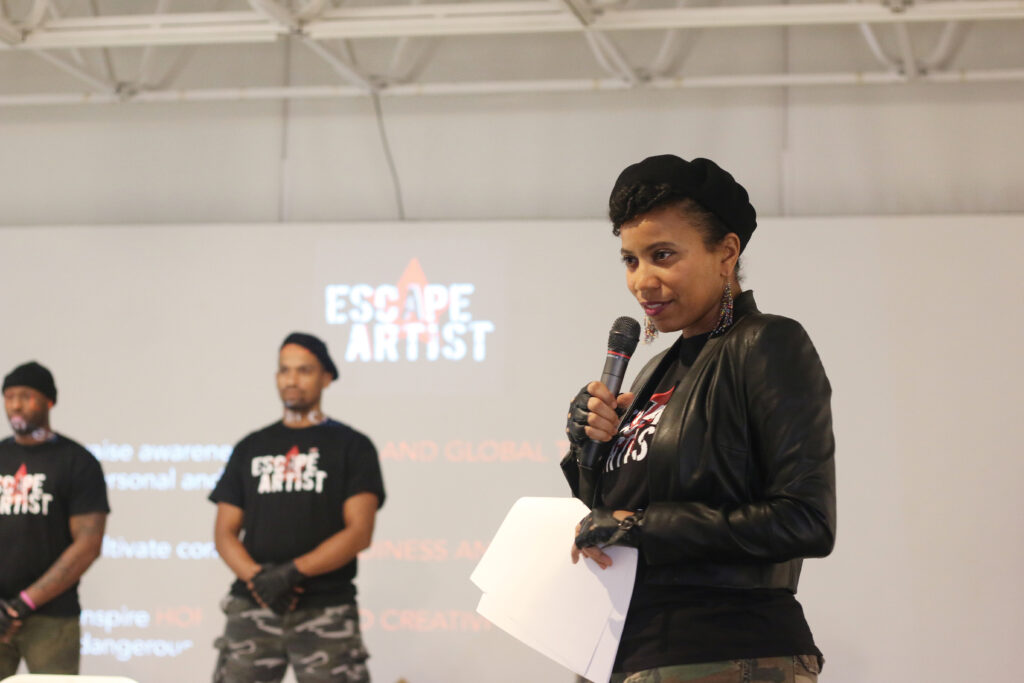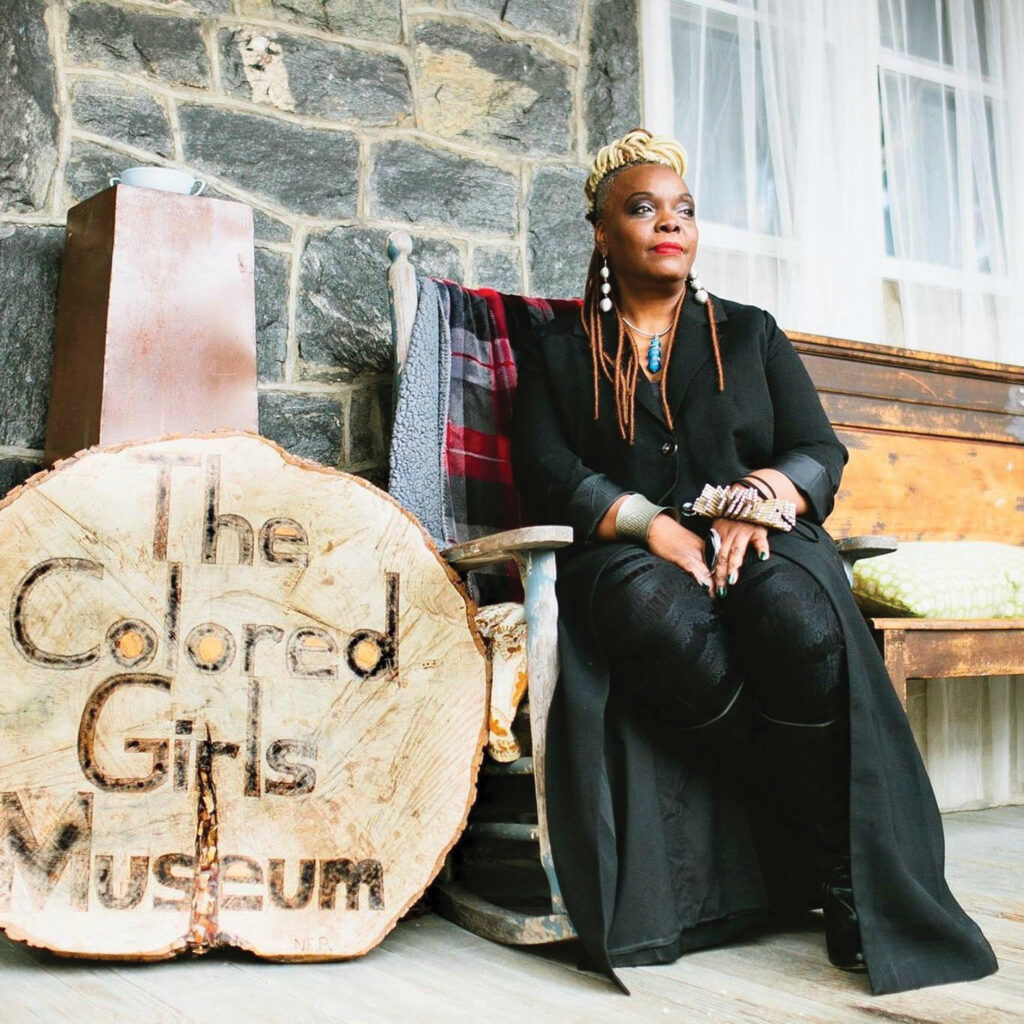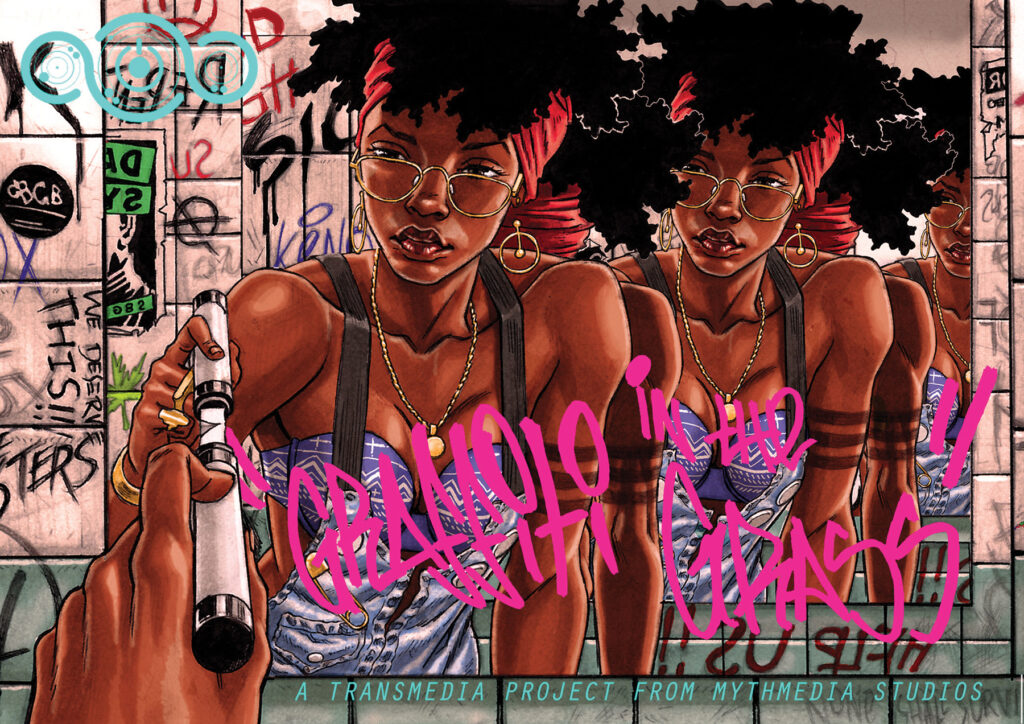
Artist Li Sumpter leads an
Escape Artist Initiative workshop,
a community-based project exploring the art of survival and creative resilience. Photo courtesy of Li Sumpter.
Black sci-fi writer Samuel Delany says, “images of tomorrow,” are what black people need most. Powerful black images are the seeds of transformative black stories—stories black folks can identify with, believe in, and heal through. Imaginative, authentic narratives about black lives and radical afrofutures disrupt stereotypes and shift perceptions. We know a story holds power when we want to become a part of it, engage with its characters, remember the journey through our own eyes and experiences. Such stories are immersive by nature. To these alchemical ends and technological means, black artists and storytellers working in 3-D design and immersive technology are leveling up on tools for social change and our souls’ survival.
As we witness the turn of the decade, many projects emerging from the nexus of art and technology offer a glimpse into the ever-evolving terrain of art and social practice. These projects explore new strategies for creative resistance while redefining what art and story can look, feel, and sound like across multiple platforms. This includes innovative work from multidisciplinary fields like digital humanities, immersive storytelling, design justice, and afrofuturism.
Octavia E. Butler says it is our1 destiny to, “take root among the stars.”
Octavia believed humanity’s destiny is our choice, by design. I strive to be in the same orbit with fellow humans who hold similar hopes for the future of the planet in the face of urgent ecological crisis. When it comes to my art and approach to collaboration, this alignment is essential to ensure the growth of my practice and its impact within my arts ecosystem. I try to surround myself with other artists, storytellers, makers, dreamers, designers who understand the power of myth and radical imagination. These symbiotic connections and collective resources exist as a creative network activated across disciplines and diverse communities. What follows is a snapshot of black stars constellating in my cosmos, a few glowing nodes in my network I’d like to shout out and show some love. The epicenter of my multiverse is rooted in my hometown of Philly, Planet Earth.

Executive Director and founder Vashti DuBois sits in front of The Colored Girls Museum. The museum honors the stories, experiences, and history of ordinary Colored Girls. Image courtesy of The Colored Girls Museum.
The Colored2 Girls Museum – FIRST TIME EVER I SAW YOUR FACE
When it comes to holding safe and sacred space for black girls and women, The Colored Girls Museum (TCGM) in Germantown, Philadelphia has made this Her die-hard mission. TCGM is a 130-year old historic home that has been so lovingly and purposefully transformed into a public space of community ritual in “protection, praise, and grace of the ordinary colored girl.” Under the leadership of Vashti Dubois, the Museum uplifts images and stories of black and brown girls and women in ways the world and our own communities of color have rarely seen.
In 2019, I was an exhibiting artist in a group show TCGM co-curated for the Leeway Foundation at Moore College of Art and Design, where I also teach curatorial studies and afrofuturism. This year, I’ll be working with Vashti and a Philly-based national team on an immersive tech portrait project called The First Time Ever I Saw Your Face. Augmented reality, green screen, and 360 volumetric video are among the tools that will bring portrait artists, their subjects, and their stories to life for Museum visitors of all ages and abilities.

Filmmaker M. Asli Dukan uses the stories of five generations of her matrilineal legacy to transmit the experience of healing as a form of liberation in The Healing Box. Image courtesy of
M. Asli Dukan.
M. Asli Dukan – THE HEALING BOX
M. Asli Dukan lives and creates in Philly where her practice is based. Her current project The Healing Box is an interactive, multimedia project inspired by the sci-fi story Dune and five generations of voices from Dukan’s own matrilineal legacy from the 1800s Caribbean to 21st century United States. he Healing Box turns a device intended to inflict pain and trauma into a tool of remembrance and healing. Through “a multicolored light display and a series of sound designed, audio montages” participants are enveloped in a sensory experience of survival, resilience, and memory recall. This project is part one from Dukan’s forthcoming Maria Trilogy. The second and third parts address “themes of work and love, and add video and virtual reality to their forms.”
I first met Asli when she was shooting for her documentary on afrofuturism some years ago. We share a blerdy passion for the Dune mythology, and are both mining and re-membering personal ancestry through speculative artifacts and interactive installation. Most recently we’ve crossed paths in a popular maker space in Philly called NextFab Studios. Utilizing new technologies to bring lost and forgotten, untold and still unfolding stories into “mixed” or multiple realities connects Vashti, Asli, and I, and our respective projects, within this same arts ecosystem. Creating immersive narrative experiences is a viable path we’ve all chosen to expand the possibilities of our work, and the radius of our impact in Philly and beyond. In the process, we’re also transcending the limitations of our current skill sets and scopes of knowledge.

Wangechi Mutu’s sculpture, The Seated III, 2019, overlooks from the façade of The Metropolitan Museum of Art. Photo by Allison Meier. Edited and cropped from original.
Wangechi Mutu – THE NEWONES, WILL FREE US
When sharing her inspiration for the current portrait project at TCGM, Vashti recalled a visit to a local Philadelphia institution where she saw paintings of wealthy white men hung high on the walls. Visitors had to “look up” to them upon entering a room, creating an immediate dynamic of power, respect, and, even, intimidation. Vashti’s memory made me think of the recent work of one of the brightest stars of modern mythmaking I’ve ever had the pleasure to encounter.
Kenyan-born artist Wangechi Mutu is making new myths and monuments that humans of color (and the rest of humanity) can (and literally, must) look up to. Across many world mythologies, the black woman represents the Creatrix of life and symbol of Mother Nature. Through her groundbreaking façade commissioned by The Met entitled, The NewOnes, will free Us, Mutu conjures spells of power and protection, hope and liberation for women across time, space, and art history. Informed by ancient caryatids and supported by 3-D design, these larger-than-life female figures belong to a speculative future imagined through Mutu’s mind’s eye. Making space for the lost and displaced, The NewOnes hold high court and stand watch for “us” in the real world, from what is easily considered the most iconic institution of arts and culture across the globe.
I first met Wangechi while working at the New Museum during the run of Black President: The Art and Legacy of Fela Anakulapo-Kuti. In the almost 20 years since our paths first crossed, Mutu remains a Morning Star to me—always shining a light of hope, pointing black folks, women, and the archetypal Other, towards True North. If our destiny is to take root among the stars, Mutu is leading the way in quantum leaps and bounds. Her thoughtful execution of The Met commission elegantly succeeds in subverting recurring images and motifs of women in service and submission in classical art and architecture that spans millennia. While The NewOnes stand as temporary monuments to the strength, resilience, and regality of the female body, they also speak proudly and loudly to humanity’s urgent call to save us from extinction and planetary destruction.

An interactive, transmedia project, Graffiti in the Grass promotes creative resistance and community readiness through an apocalyptic myth set in future Philadelphia. Image courtesy of Li Sumpter.
Li Sumpter – GRAFFITI IN THE GRASS
Like Vashti, Asli, and Wangechi, by design, I choose to put girls and women of color at the center of my stories about the art of survival, a concept at the core of my multidisciplinary practice. Roxi RedMoon, a young heroine of African and Indigenous descent, is the heart of Graffiti in the Grass, my immersive transmedia project. Graffiti utilizes escape room, graphic novel, mixtape and mobile app to connect participants/users to Roxi’s existential struggle and her quantum quest through time and space. This story and my other MythMedia and Escape Artist projects are strongly informed by my doctoral research on apocalyptic narratives and archetypal patterns recurring across media landscapes, the natural environment and human consciousness.3
The Apocalypse Complex (aka Sarah Connor Syndrome) is one such pattern and pathology. I describe it as an archetypal algorithm of birth, death, and rebirth that influences psychic life and material reality. Like many living in her time (c. 2045), Roxi RedMoon suffers from anxiety, depression, and suicidal ideation brought on by the shadow of the Apocalypse Complex. While facing unthinkable challenges of ecological and societal collapse, Roxi is also charged with finding her missing sister and saving her community from cosmic annihilation. But first, Roxi must dig deep to overcome the shadow of her own soul before she can begin the journey to help the ones she loves.
In this apocalyptic multiverse, black and Indigneous women are not only the heroines of the human race, they are also the saviors of their own precious souls. Project participants experience Roxi’s journey while also learning practical, holistic survival skills for mind, body, and spirit. Vashti has invited me to playtest immersive story elements from Graffiti in the Grass in The Colored Girls Museum’s physical and virtual spaces. This collaboration has granted me access to an experimental platform equipped with state-of-the-art resources unlocking the power to push my speculative story beyond the realms of myth and media and into real-world dimensions.
Who speaks for us? Who tells our stories? Who builds our worlds? Who will remember us when we’re gone? I strive to be in good company or at least in close orbit, with the likes of Vashti, Asli, Wangechi and others asking and answering similar questions at the crossroads of art, race, access, and technology. Wangechi says the characters of her story are, “activists and environmentalists who present a different approach for the future, because none of the amazing works of art and language and theater that we’ve created throughout the history of humanity will matter if we’re not here as a species.” Facts!
No matter race, gender, faith, or discipline, artists, storytellers, designers, educators, and activists engaged in visionary, generative social justice work are all connected through independent acts of world building. Whether we know it or not, we are in simultaneous co-creation of the “big picture,” the next new reality. We are collectively making new myths and Techno-colored constellations of image and media that show us just how dark or luminous humanity’s futures can be. The field of imagination is both the frontline and ground zero in the battle for our brightest tomorrow. We must choose our tools of change wisely and always with hope in our hearts. Our destiny is our choice, by design.
Li Sumpter, PhD is a scholar and multidisciplinary artist who applies worldbuilding strategies and mythic design toward building better, more resilient communities of the future. Her work explores the anatomy and aesthetics of apocalypse focusing on feminine archetypes in End Time and afrofuturist narratives. Li’s collaborative design initiatives engage the art of survival and sustainability through diverse ecologies and creative problem-solving. Li recently completed artist and writer residencies with Haverford College’s Urban Ecology Arts Exchange (2018), Leeway x NextFab Art and Technology Residency (2019) and SWIM PONY’s Trail Off land-based project (2019/2020). She’s a three time recipient of the Leeway Art and Change Grant and was awarded support from Sundance, Knight, and Puffin Foundations for her transmedia project Graffiti in the Grass. Li is also an educator and eco-arts activist working through MythMedia Studios, the Escape Artist Initiative, and various arts and community-based organizations in Philly and across the country.
Notes
1. “Our” refers to “Earthseed,” what Octavia Butler called humanity in Parable of the Sower.
2. To Vashti DuBois the term “colored” means, “the act of coloring—the verb itself refers to how the world consistently takes its crayons and colors black women and girls whatever they want. They color us too loud. Color us as too aggressive, as needy not in need of protection. They just color us. And then the colored girl will take that same crayon and begin to color herself and her people.”
3. My dissertation Apocalyptic Soul: Seeing Through Image in the Age of End Time further explores these concepts in mythology and depth psychology.


